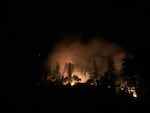A wet spring earlier this year and recent rainfall have helped dampen ongoing fires in the region. But fire officials caution that danger still exists in the fall months, especially due to wind and human-caused fires.

The Flat Fire is burning in Southwest Oregon.
Flat Fire Facebook Page / Jefferson Public Radio
Even though rain is beginning to fall, wildfire season isn’t over yet in Southern Oregon and Far Northern California.
Liv Stecker, a PIO with the Rogue River Siskiyou National Forest, said pinpointing the beginning and end of fire season is difficult, based on weather and other factors.
“I think we started out a little bit later this year. But then we might be winding down a little bit earlier than we have in years past. I know that when I’ve been here before on fires, you know, we’ve been here till the snow flies. Whether that is the case this year or not kind of remains to be seen,” she said.
The Flat, Anvil and Smith River Complex Fires continue to burn in the area of the Rogue River Siskiyou National Forest.
Still, Stecker said they’re optimistic that we’re currently through the worst of fire season, and she doesn’t anticipate much more fire activity in the coming weeks.
She said fewer acres have burned so far this year compared to years past. 56,456 acres have burned so far this year in the National Forest from 90 total fires. However, 88 of those fires account for only 122 acres. The rest of the burned acreage comes from the Flat and Anvil Fires.
It can be hard to tell how recent rain will affect the rest of wildfire season.
“The fire seasons tend to get longer and longer as the years go by,” said Larry Kurtz, PIO with the Smith River Complex. “Right now, yeah, the rain is definitely a gift to us. But too much rain can also be a double-edged sword. If you have too much rain, then what you have is a lot of rainfall, and a recent burn scar without any trees or brush systems to prevent rockslides or mudslides or problems with the roads and access.”
JT Zulliger, battalion chief in charge of fire prevention and law enforcement in Cal Fire’s Shasta-Trinity unit, said recent rains have helped make this year less busy than previous years, but the fall months are when this region tends to get more wind.
“We by no means are out of that window. So there is a potential that we still could see wind, and when we do get the winds, the potential for wind-driven fires goes up, and wind-driven fires tend to be our most damaging and devastating fires,” he said.
Some of that danger is due to human-caused fires. Fire officials caution that just because some rain has fallen, that doesn’t necessarily mean it’s safe to burn debris.
“That’s something that we always seem to struggle with, again, in this area is people not knowing the difference between still in fire season but still dropping our fire danger, and then people seeing that there’s rain, so ‘Oh, I can burn.’ So I think that’s something that we always struggle with,” said Jennifer Case, PIO for the Klamath Lake District, Oregon Department of Forestry.
For instance, Zulliger said fires happen each year when people clean out their wood stoves and dump the ashes outside, thinking the coals are out.
“The fuels are still receptive enough and dry enough that we have seen several vegetation fires caused from discarded ashes from people cleaning out their wood burning stove,” he said.
According to the South Central Oregon Fire Management Partnership, which covers South Central Oregon and Northwest Nevada, 133 fires have burned in that area so far this year, totaling about 13,415 acres. That compares to 198 fires last year, totaling about 3,165 acres.
Grass and brush in the region can still be dry and burn easily, so fire officials encourage caution in the coming months.